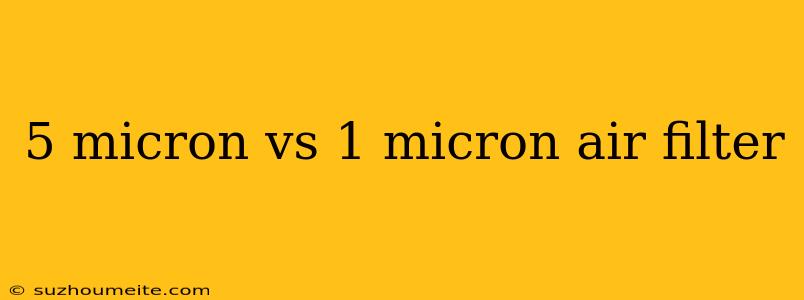Air Filter Showdown: 5 Micron vs 1 Micron
When it comes to air filtration, the size of the filter's pores is a critical factor in determining its effectiveness. Two common sizes of air filters are 5 micron and 1 micron, but what's the difference between them? In this article, we'll dive into the details of each and help you decide which one is best for your needs.
What is a Micron?
Before we dive into the comparison, let's define what a micron is. A micron is a unit of measurement that represents one-millionth of a meter. In the context of air filters, it refers to the size of the filter's pores. The smaller the micron rating, the smaller the pores and the more efficient the filter is at capturing smaller particles.
5 Micron Air Filter
A 5 micron air filter is a relatively coarse filter that can capture particles as small as 5 microns in size. This filter is suitable for capturing larger particles such as dust, hair, and other debris that can clog up your airways. While it's not the most effective filter, it's still a good choice for:
- General-purpose filtration: 5 micron filters are suitable for general-purpose filtration in homes, offices, and other areas where air quality is not critical.
- Pre-filtration: They can be used as a pre-filter to capture larger particles before they reach a finer filter, such as a HEPA filter.
Pros:
- Less expensive: 5 micron filters are generally less expensive than 1 micron filters.
- Higher airflow: They have higher airflow rates, making them suitable for applications where high airflow is required.
Cons:
- Less effective: 5 micron filters are less effective at capturing smaller particles, including some bacteria and viruses.
- May not meet regulations: In industries that require high air quality, such as healthcare and pharmaceuticals, 5 micron filters may not meet regulatory requirements.
1 Micron Air Filter
A 1 micron air filter is a finer filter that can capture particles as small as 1 micron in size. This filter is suitable for capturing smaller particles, including:
- Bacteria: 1 micron filters can capture most bacteria, including E. coli and Salmonella.
- Viruses: They can also capture some viruses, including influenza and coronaviruses.
- Fine dust: They can capture fine dust and other small particles that can aggravate respiratory issues.
Pros:
- High-efficiency filtration: 1 micron filters are highly effective at capturing small particles.
- Meets regulatory requirements: They meet regulatory requirements in industries that require high air quality.
Cons:
- More expensive: 1 micron filters are generally more expensive than 5 micron filters.
- Lower airflow: They have lower airflow rates, making them less suitable for applications where high airflow is required.
Conclusion
When choosing between a 5 micron and 1 micron air filter, consider the level of air quality required for your application. If you need general-purpose filtration for a home or office, a 5 micron filter may be sufficient. However, if you require high-efficiency filtration for a critical application, such as in a hospital or pharmaceutical lab, a 1 micron filter is the better choice.
Remember: Always check the specifications of the filter you choose to ensure it meets your needs and any regulatory requirements.
